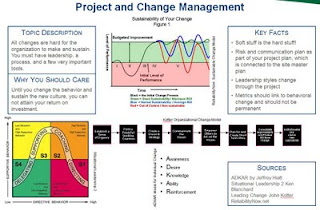The last single point lesson in this series covers project and change management. Three models are used to make sure everyone understands that improving reliability is a “big deal” change and that it has to be treated as such. With that said they must think about individual, organizational, and leadership change in order to be have the best chance of success.
The first two models can almost be treated as checklists at their simplest level (if you dive deeper they yield much more insight). They include Kotter’s model for organizational change management and the ADKAR model for individual change from Prosci and Jeffery Hyatt. These models help us see when we need to do certain steps, why we need to do them, and what can happen if we miss or skip a step. Both models are very linear processes, which works great for those of us (engineers) who are drawn to the sequential things in life. If you follow them in order they will increase your likelihood of success by moving the effected individuals and the organization as a whole forward through the valleys of change where they become easily overwhelmed and on to the new level of performance.
The last model is the change curve, which is based off of Blanchard’s model for Situational Leadership 2. It shows that the needs of the effected parties will change as they mature through the change process. This means that as leaders, we must change as well. In the four-box graphic, you can see what these individuals will need as they progress, and the numbers in each box correspond to the areas shown with roman numerals in the Sustainability of Your Change model.
Ultimately, the real take away is not these five single point lessons; it is the understanding for why they exist. We need to communicate the reliability message multiple times from different people in different ways, and in the end, the listeners should all come to the same conclusions, which allows us to get the required results. Use these single point lessons or create your own and communicate, educate, and assimilate your way to excellence in reliability.


No comments:
Post a Comment